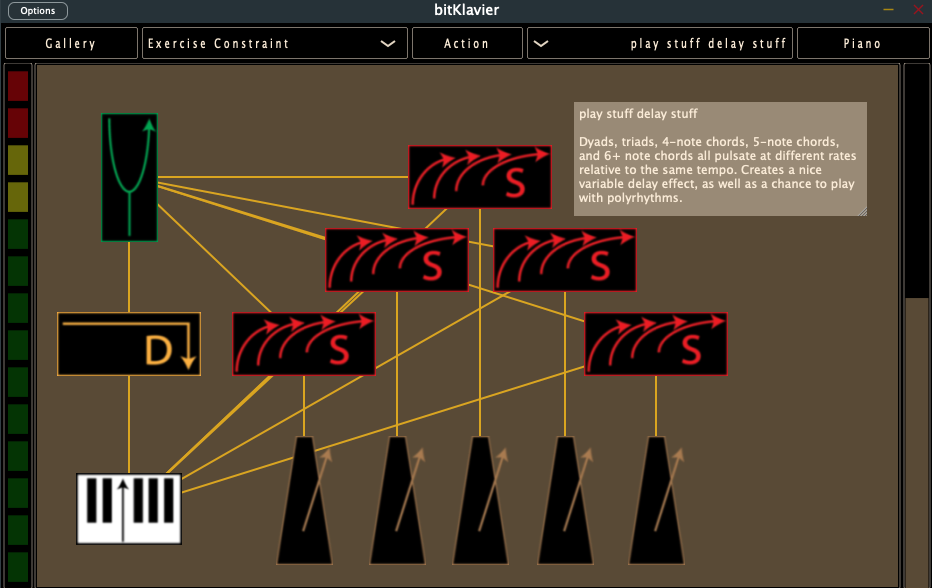v2.4 now available
We have a new version for you all to try! While the updates are subtle, they are nifty, with significant musical possibilities.
Synchronic
has two new ways to constrain how clusters are identified:
velocity limiting: define a range of velocity values that will be included (or ignored) so you can, say, only launch pulses when you play loud.
duration limiting: similarly, you can set a range of performed durations that are included (or ignored) so you can, say, play short notes and not have them launch pulses.
this only makes sense if clusters are determined by noteOff messages, so Synchronic has a new Key Off mode for constraining clusters; best to try it out!
Also new, you can now launch a number of Synchronic layers, all within a single Synchronic preparation; you might think that would be the same as having multiple Synchronic objects, but it's a bit different; again, check it out to see what we mean! And there's more...
To accommodate these new parameters, we've restructured the preparation views so they have multiple panes that you can move through; it should be much clearer and cleaner to work with. Here's what it looks like:
Nostalgic
Like Synchronic, Nostalgic also has velocity limiting and duration limiting, which is really nice for constraining how often those reverse notes come in. Both of these limiting features are particularly useful in improvisational contexts.
Nostalgic also has a new cluster min parameter; similar to the Synchronic, it sets a minimum number of notes to be released within a small timing window (the cluster threshold) to launch the reverse waves.
Finally, when key-on reset is toggled on, currently sounding Nostalgic notes will be interrupted when they are played again; this is a nice way to play with Nostalgic textures without it always building up.
Again, new windows to make things cleaner and easier to understand:
Tuning
Spring tuning was the big addition in v2.3, and we've made a few refinements that make it more powerful and easy to use. Here goes...
You can now have the fundamental for the interval springs set automatically; basically, it looks at the notes you are playing and determines what the best fundamental would be, using an algorithm analogous to the psychoacoustic effect known as a the missing fundamental—if you aren't familiar with that, check it out, it's pretty cool!
In addition, you can have the anchor spring weights track the fundamental, rather than having to set them all manually and then have them static; this is a nice way to have the springs dynamically constrained. This will work whether you use the new automatic mode, or the previously existing last, highest, and lowest modes, or even if you just set the fundamental manually.
Finally, you can mix and match interval springs based on the fundamental, or locally (as if in none mode). For instance, when in a conventional just tuning, with a fundamental of C, the D-A fifth will be really flat. If you set the fifth to be set locally (L) instead of by fundamental (F) with the button next to the P5 interval weight slider, all the fifths will have the 3:2 ratio.
We've got a journal article in the works that describes all this in detail, and our manual also has a pretty thorough explanation, so don't worry if this is confusing! Here's what the new spring tuning window looks like with these new features active:
This is a stack of fifths—C-G-D-A—which the automatic algorithm then determines that the fundamental should be C. Since the fundamental "sets weights" is active, all C's will have anchor weights of 0.5 and the other pitches will have anchor weights of 0.1. Finally, the P5 is set to have an interval spring length that ignores the fundamental, so it will be set to the Pythagorean 3:2 fifth, and it's strength is also stronger than the M6 spring, so this stack of fifths will be all nearly perfect. Nearly...
Exercise Constraint!
Mike has been working on a new example gallery called Exercise Constraint, specifically targeting improvisors and demonstrating some of the new features; this should be useful for exploring the new features and incorporating bK into improvisational contexts.
Other Schtuff
Finally, you can now export and import individual pianos and individual preparations; these are saved in corresponding folders in your Applications/bitKlavier directory, so you can easily share them with others, or create your own library of pianos and preparations that can be used in different galleries.
bitKlavier has been showing up in some unusual places, including a performance of all 24 Preludes and Fugues from Bach's WTC1, presented by Legacy International; preparing the digital piano to play Bach?!? See the poster below.
Earlier this spring, Cristina Altamura, founder of Legacy, took bitKlavier to the legendary Imola Piano Academy in Italy for some workshops; more in the works there for the future.
There is lots more in the works for bitKlavier as well; stay tuned.
v2.4 is available for Mac, Windows, and iOS, in standalone and VST/AU plugin formats. And the manual has been updated, so make sure you are looking at the v2.4 manual!







